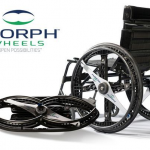It seems all to often that we post about damage to wheelchairs that occurs during air travel. This is a time that we hope and trust that the handlers, who move many thousands of items each day, take good care of our precious wheelchairs and that they recognise that wheelchairs require a little more care than the average suitcase or backpack.
Travel can be stressful enough for anyone in these times of heightened security whether you are a wheelchair user or not. Queues seem longer and the various checks seem to become more involved at ach end of your flight. In some respects there are benefits of travel in a wheelchair ! yes we do at least have somewhere to sit the whole time and often as not we get some form of priority when it comes to boarding.
The downside as we all know is the unknown treatment of our mobility equipment and in particular the wheelchair. The potential problems of air travel as a wheelchair user start fairly early on and include the obvious issues of actually getting on the plane, then moving on to difficulties checking in any equipment, and then once on the plane being able to go to the toilet is also a challenge that many of us cannot overcome.
So any resulting damage to wheelchairs is the biggest concern of all. From reading a number of articles of the past few years it would appear that both electric wheelchairs and manual wheelchairs are having the same types of problems that ultimately are preventing some trips.
Some electric wheelchair users have resorted to using a manual model with a powerpack to reduce the chance of damage to their power chairs. Mainly because when flying, the motor can be stored in a suitcase where the idea is that the more breakable parts are kept safe.
Having read up on various folks experiences it seems the whole wheelchair travel saga can be broken down in to some simple but reoccurring issues:
1 The handling of the wheelchairs by airport staff
2 The handling of compensation post incident
3 The provisioning of a replacement wheelchair to facilitate continuation of holidays or everyday life
In the eyes of the airline industry, it seems that a wheelchair is the same and equally as robust as any other piece of luggage and can therefore be being flung on to a trolley of suitcases and powerchairs can be left lying on their sides while being moved on conveyor belts.
In addition, it is often the more fragile wheelchair accessories including supports and removable parts that get the worst treatment and sometimes simply go missing as they could not be reattached.
We all know that all wheelchairs are different, but you would think that given some basic training all airport staff would do a better job and it would benefit all wheelchair users in the meanwhile. It would also help to keep their costs down as repairing broken wheelchairs and particularly powerchairs is not a chap pastime.
As for any compensation, it is often made incredibly difficult to successfully claim fully for the loss and inconvenience. So much so that one man has who set up an organisation called Reduced Mobility Rights after experiencing the challenges of travelling with his disabled son and his wheelchair. Roberto Casiglioni now helps others to make successful compensation claims for damage and or mistreatment.
The unfortunate downside of all of this is than many folk find themselves unwilling to entrust their all important wheelchair to an industry which all too often seems not to recognise their value and get it wrong. So any final tips for those who are embarking on some air travel this summer ?
Remove all detachable parts such as head rests, arms rests, footplates and joysticks from the wheelchair and carry them onboard.
If you can, then why not submit a Special Declaration of Interest before flying, allowing compensation claims above the usual cap to be made should there be a problem.
Label wheelchairs clearly with instructions on how to move them and which parts should not be used to lift and carry.
These simple steps should go a long way toward protecting your cherished wheelchair and allowing you to travel safely and not fretting about your wheelchair.


















